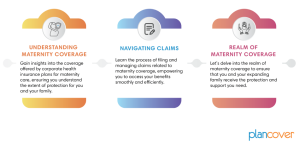TEST 1
Unraveling Maternity Coverage
in Corporate Health Insurance
An Employee’s Guide to Finding the Best Maternity Coverage
in Corporate Health Insurance

Welcome to our comprehensive guide on maternity coverage within corporate health insurance policies. As an employee, understanding the nuances of your health benefits is crucial, especially when it comes to maternity coverage. This guide is designed to demystify the details of your policy, providing you with the knowledge to navigate the financial aspects of pregnancy and childbirth confidently.
Understanding Your Corporate Health Insurance Plan:
The first step is to thoroughly understand your corporate health insurance plan. This includes knowing what maternity services are covered, the extent of the coverage, and any limitations or exclusions. It’s also important to understand the terms of the policy, such as the waiting period for maternity coverage, the claim process, and any co-payments or deductibles that may apply.
Why Maternity Coverage Matters:
Maternity coverage is more than just a policy feature; it’s a cornerstone of your family’s health and financial planning. With the rising costs of healthcare, particularly in metropolitan areas, having robust maternity coverage can significantly ease the financial strain associated with welcoming a new member to your family.

Maternity coverage in corporate health insurance plans is tailored to provide comprehensive support to employees throughout the childbirth process. This coverage serves as a vital resource, offering financial assistance and peace of mind to expectant parents during this significant life event.
Additional Considerations:
Be Aware of Exclusions: Certain procedures or services might not be covered, such as high-risk pregnancy complications or specific birthing interventions.
Pre-existing Conditions: It’s important to understand how your plan handles pregnancy-related complications arising from pre-existing conditions. Even if your plan covers pre-existing conditions in general, there might be limitations on coverage for pregnancy-specific complications. Additionally, some plans might have a separate waiting period specifically for maternity coverage, even if other aspects of your health insurance are active from day one. Be sure to clarify these details with your HR department or insurance provider.
Example:
Sarah, employed at a tech startup, is expecting her first child. She reviews her company’s benefits booklet and learns that her corporate health insurance covers:
Prenatal Care: Up to Rs. 5,000 for doctor visits, ultrasounds, and other pregnancy-related tests within maternity limit
Delivery: Up to Rs. 1,00,000 for both normal delivery and C-section costs.
Newborn Care: Up to Rs. 5,000 for the baby’s hospital stay and initial check-ups.
She also discovers that her plan excludes coverage for elective C-sections and has a sub-limit of Rs. 7,000 for hospital room charges per day .